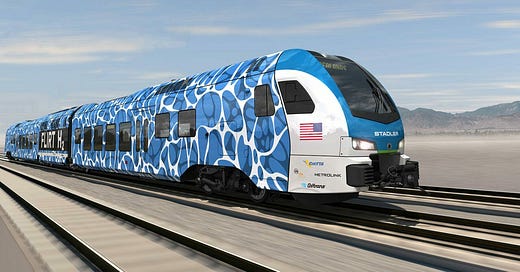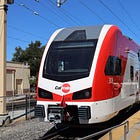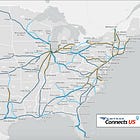America’s hydrogen train fixation, explained
Electrified trains are the ‘gold standard.’ Why is the U.S. embracing hydrogen trains instead?
Most railroad planners and engineers will acknowledge that electrification by overhead wire is the best train propulsion technology. Electrified trains are cleaner, faster, more powerful and more efficient than diesel trains. And they have a better range and better track record than new-fangled competitors like battery-electric and hydrogen fuel cell trains.
“The gold standard is overhead catenary electrification, if you can do that,” Kyle Gradinger, assistant deputy director for rail at Caltrans told me in an interview for a recent piece in MIT Technology Review. But electrification is not what Caltrans is doing. Instead, the agency is spending $207 million to buy ten hydrogen train sets for California’s three main intercity Amtrak routes, and planning for a lot more hydrogen trains in the future.
California is at the vanguard of the hydrogen train revolution, but it’s not an anomaly, at least not in the U.S. As emissions regulations call for a transition to clean energy sources, America’s railroads are veering away from the international best practice of railroad electrification and are instead turning to hydrogen as their preferred solution.
My story in the latest issue of MIT Technology Review explores the pros and cons of different railroad propulsion systems in depth, and the regulatory and technological considerations for railroad decarbonization. (The online version is paywalled, so go buy a print copy of the May-June issue on newsstands!)
In this post, I want to zoom in on the contradiction highlighted above. Why is electrification being marginalized in the America’s railroad decarbonization debate when it’s widely acknowledged to be a superior technology? Why is hydrogen emerging as the apparent railroad propulsion technology of the future despite many outstanding questions and concerning signs?
The answers to these questions are to be found in America’s infrastructure power structure. Ultra-profitable freight carriers reject electrification for a variety of operational and financial reasons. Meanwhile, energy companies and utilities view hydrogen as their saving grace in the energy transition, and are lobbying hard to move as much of the economy as possible to hydrogen power. Government officials and agencies are heavily influenced by these two powerful interest groups. And so hydrogen looks like the track of least resistance.
To get electrification back on the agenda, passenger rail advocates are going to have to get a lot louder. And they are going to need champions in government who are willing to take political risks for a proven technology.
The Freight Railroads
The vast majority of America’s 150,000 or so miles of active railroad track are owned by five freight rail companies: Union Pacific and BNSF in the west, CSX and Norfolk Southern in the east, and Canadian National in the midwest and along the Mississippi river. These companies are enormously profitable, paying out $146 billion in stock buybacks and dividends over the 2010s.
Nearly all long-distance and state-supported Amtrak routes run on freight-owned tracks. The main exception is the Northeast Corridor, where public ownership of track enables electrified trains to run at high frequencies and high speeds.
Generally speaking, the freight railroads have not been amenable to the electrification of their tracks. The cost to electrify the entire national rail network would be in the “hundreds of billions” of dollars, an industry trade group says. The companies are also concerned about overhead wires interfering with double-stacked trains. And, crucially, they view electrification as a prelude to increased passenger service, which could, in theory, reduce freight carriers’ access to tracks.
There are very real logistical impediments to large-scale railroad electrification projects, especially across the vast American west. The poles and wires that power electrified trains would need to be rugged enough to withstand wildfires, earthquakes, and other natural disasters. Getting power to these remote locations wouldn’t be easy, either, requiring significant new electric transmission capacity. Which leads to the other major player here…
Utility and Energy Companies
Transmission lines and grid hookups are now some of the biggest impediments to America’s green energy transition. The same challenge applies to rail electrification projects. Railroads would need to work with a broad range of regulatory agencies, local governments, and utility companies to get power to their tracks.
What’s more, some utility companies have been known to delay hookups for renewable energy developers and other power users they don’t like. There’s reason to believe some of these companies won’t like rail electrification, because they really like hydrogen.
Federal lobbying on initiatives related to hydrogen increased ten-fold between 2020 and 2021, and have remained at that elevated level ever since. Most of that spending is coming from big fossil fuel companies. Natural gas utilities, like SoCal Gas, which is planning the nation’s largest hydrogen energy system in the LA basin, are also bullish on hydrogen. These companies already have much of the infrastructure and expertise to produce it, typically by burning methane. The substance could serve as a bridge for these companies to navigate the energy transition, especially if they can perfect elusive “green hydrogen,” which currently makes up a small percentage of all hydrogen production.
Federal and state governments
All of this lobbying has won hydrogen friends in high places. The 2021 Bipartisan Infrastructure Bill dedicated $9.5 billion in subsidies to hydrogen, and the Inflation Reduction Act dedicated still more. California, one of seven federally-designated “hydrogren hubs” that will receive a big chunk of these subsidies, has a powerful bipartisan pro-hydrogen caucus in the state legislature.
Of course, hydrogen has many more applications than railroads. But when state and federal governments are already spending big on hydrogen research and development, hydrogen heating and cooking, and hydrogen trucking, it seems fitting for railroads to join the party.
By contrast, there are no major interest groups lobbying on behalf of railroad electrification. There are no dedicated federal funding sources for this purpose, and none that I’m aware of in any state government. Other countries, like India and the UK, have made it government policy to electrify their railroads, and have greased the wheels with mandates and direct funding sources.
America’s nascent high-speed rail industry could offer a glimmer of hope for railroad electrification supporters. Here, just maybe, is a powerful interest group whose product requires wire over steel tracks. (Electrification is usually necessary to reach speeds of over 125 miles per hour.)
Yet, for the most part, current high-speed rail plans are avoiding conflict with freight companies by building track along new corridors. Instead of electrifying our current railroads, we just might get a limited high-speed network awkwardly overlaid upon the existing diesel and hydrogen powered system. That emerging paradigm will move a lot fewer passengers, for a lot more money, than electrifying key passenger corridors that already exist.









Thanks for this excellent article, Ben! Having recently visited Japan, I've wondered why we haven't developed a Bullet Train to Los Angeles......
In CA, the push for zero-emissions transit has been a mistake from the start. What's far more needed is a reduction in single-occupant auto travel, as that's where the huge bulk of GHG emissions come from. However, the state's political establishment refuses to get involved with how people travel, because of potential backlash. So they focus on irrelevant gestures like H2 locomotives. While getting people on transit is FAR more important, the state's planners don't want to encourage transit use by pushing transit-oriented development. (A very heavy-handed legislative approach to this failed badly.) We simply haven't had decent policy discussions in this state.
BTW, your reference to "new-fangled" seems to suggest a 1990s perspective. Battery electric is now a viable alternative to continuous catenary, needing only short stretches of catenary at stations and on steep grades.